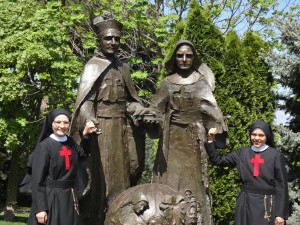A Talk Given by Mother Zélia Andrighetti, Superior General of the Daughters of St. Camillus
 The Blessed Luigi Tezza (1841-1923)
The Blessed Luigi Tezza (1841-1923)
The month of September for us, the Daughters of St. Camillus, is at the level of our affections connected with a name, or better with a person: the Blessed Luigi Tezza! Our Founder was born on 1 November 1841 but his going to heaven took place on 26 September 1924 and this is the reason why for us September necessarily refers back to Luigi Tezza.
Ninety-one years have by now gone since his death – and as we know Fr. Terzza died in Peru, his coffin was subsequently taken to Argentina where his daughters lived, and since 1999, a year before his beatification, his mortal remains have lain in the sanctuary chapel of Grottaferrata – but his presence is very much alive amongst us and his tomb continues to be a teaching chair from which reach us constant teachings and exhortations to walk along the pathway that he outlined through the total giving of his life.
But who was the Blessed Luigi Tezza? A person like any other, with his good sides and bad sides, but so gripped by love of God that he ‘was ready for any sacrifice, any separation, any immolation, rather than lose God and displease him’,[1] and as a consequence he felt intense and tender love for his brethren, the poor, the sick and anybody who drew near to him.[2]
An only child, he lost his father when he was nine and was left on his own with his mother. At Padua the young Tezza met the Camillians and immediately felt attracted by that lifestyle, given that he had inherited from his father, who was a medical doctor, great sensitivity towards those who suffer. At the age of fifteen he was admitted to the Camillians while his mother, the next day, offered her life to God with the Nuns of the Visitation. Mother and son united by a single vocation!
During his life Fr. Tezza engaged in many activities within the Order as an educator, the head of a community, a founder, a minister of merciful love for the sick, a director of souls and a reformer.
Care for the poor and suffering, which always characterised him, led Tezza first to open himself to new activities within the Order and then to found our Congregation as a response to the need to have consecrated women trained in exercising the maternal charism that Camillus had entrusted to his disciples.
 Very many examples and stimuli for our lives, for his daughters as for his Camillian religious brothers, can be taken from the life and holiness of Fr. Tezza. I will cite only some of them.
Very many examples and stimuli for our lives, for his daughters as for his Camillian religious brothers, can be taken from the life and holiness of Fr. Tezza. I will cite only some of them.
- Spiritual profundity and openness to the signs of the times: knowing how to embody today the charism of Camillus according to the needs of our time.
- Fraternal life, lived, that is to say, in a profound and authentic way, in communion and sharing.
- Joy in service to the Lord: both in service for the sick and in relationships with other people, above all religious brothers and spiritual daughters.
The text that was written on the little picture printed after his death well captures his human and spiritual figure: ‘He was loved like a father and venerated as a saint. He is no longer amongst us but he makes us hear his teachings from his tomb. His personality and his behaviour were those of an angel: his words those of a minister of the gospel: his heart was a casket of most noble affections; his friendship was a chain of gold that imprisoned, without violence, thousands of hearts, and his mission was always the bearer of salvation. He passed amongst us like a celestial vision, always good and humble, always affectionate and charitable. Faith was the principle of his works, goodness hung on him like a cloak and crowned him like a diadem’.[3]
Blessed Luigi Tezza, our father and brother, intercede for us with God so that we may become like you: men and women apostles of the charity of Christ!
Read here the press information
[1] Positio, vol. 1, Summarium, pp. 12-13.
[2] Cf. ibid., pp. 14-16.
[3] AFSC 1/C.














Camillians on Facebook
Camillians on Twitter
Camillians on Instagram